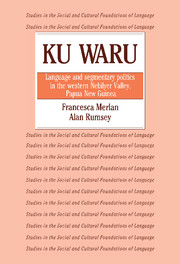Book contents
- Frontmatter
- Contents
- List of illustrations
- List of tables
- List of abbreviations
- Preface and acknowledgments
- 1 Introduction
- 2 The setting
- 3 Some aspects of Ku Waru segmentary sociality
- 4 Ceremonial exchange and marriage in the western Nebilyer Valley
- 5 Some linguistic structures of segmentary politics
- 6 Warfare compensation payment to Laulku: an analysis
- 7 Compensation at Palimung and the Kulka women's club
- 8 The events in perspective
- 9 Perspectives on ‘event’
- Appendix A Transcript of proceedings at Kailge on July 24, 1983
- Appendix B Grammatical sketch of Bo Ung, Ku Waru dialect
- Appendix C The conduct of warfare
- Appendix D Ku Waru metalinguistic expressions
- Chapter notes
- Glossary
- References
- Index
- Plate section
9 - Perspectives on ‘event’
Published online by Cambridge University Press: 30 December 2009
- Frontmatter
- Contents
- List of illustrations
- List of tables
- List of abbreviations
- Preface and acknowledgments
- 1 Introduction
- 2 The setting
- 3 Some aspects of Ku Waru segmentary sociality
- 4 Ceremonial exchange and marriage in the western Nebilyer Valley
- 5 Some linguistic structures of segmentary politics
- 6 Warfare compensation payment to Laulku: an analysis
- 7 Compensation at Palimung and the Kulka women's club
- 8 The events in perspective
- 9 Perspectives on ‘event’
- Appendix A Transcript of proceedings at Kailge on July 24, 1983
- Appendix B Grammatical sketch of Bo Ung, Ku Waru dialect
- Appendix C The conduct of warfare
- Appendix D Ku Waru metalinguistic expressions
- Chapter notes
- Glossary
- References
- Index
- Plate section
Summary
In this chapter we develop conclusions in quite a different way than we did in Chapter 8 – by attempting to characterize some of the constitutive dimensions of Nebilyer social action more broadly, widening the scope of our consideration from the public events we have examined to some aspects of everyday Nebilyer social life. One of our aims in doing this is to illuminate the concept of ‘event’ itself, a term which we have so far been using as though its meaning were self-evident.
In order to broaden the inquiry into other kinds of social action, and the role of speech, we must ask how and on what bases speech itself is constituted as a form of social action, alongside and in relation to others. The main issue we will be exploring in this chapter, then, is: how may we characterize the bases of Nebilyer social action? This leads us to examine the significance indigenously attributed to ‘events’ as occurrences which stand out from the ordinary flow of life-as-usual. We will show that there is something like a Nebilyer concept of event, which is strongly oriented towards the discovery or disclosure of new significance, both in large-scale public transactions, such as those we have analyzed in the previous chapters, as well as in everyday life, and that speech is crucial as medium and activity within the indigenously valued forms of social action in both spheres.
Part of what we seek to do by plumbing indigenous notions of event can be related to the concerns of Wagner (1975) and Strathern (in press), which we discussed in section 7.4.
- Type
- Chapter
- Information
- Ku WaruLanguage and Segmentary Politics in the Western Nebilyer Valley, Papua New Guinea, pp. 221 - 244Publisher: Cambridge University PressPrint publication year: 1991



